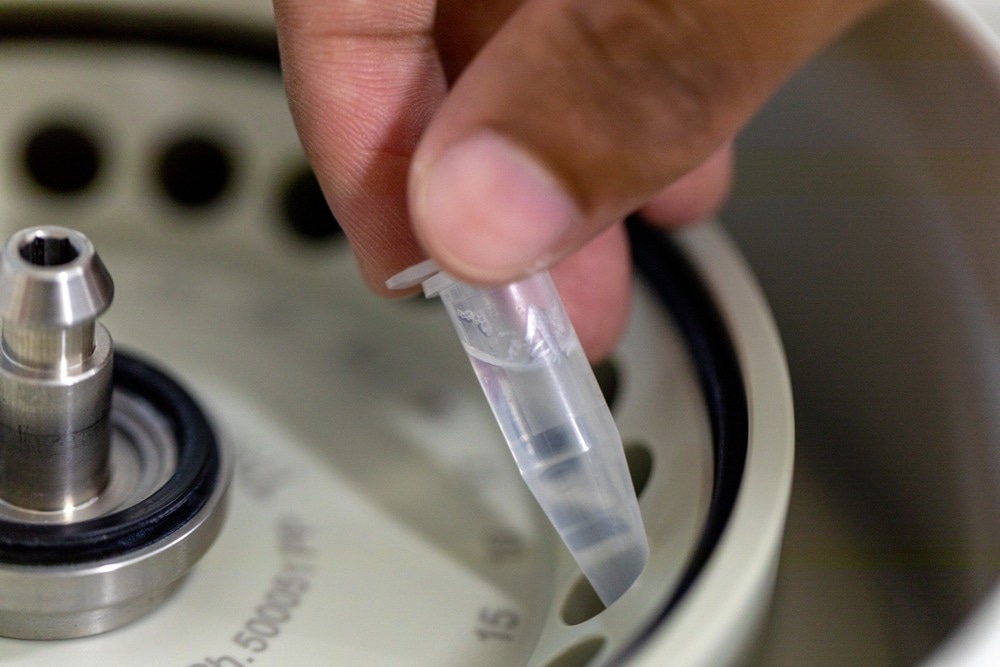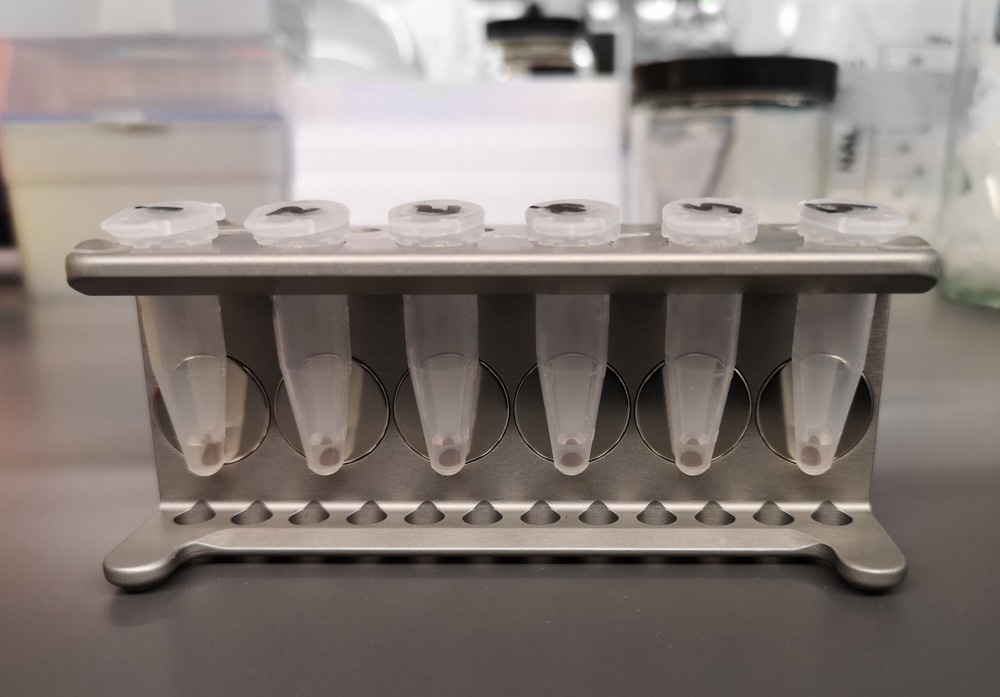For many years, magnetic beads have been used in nucleic acid purification, obtaining high yields in a short amount of time; the same method is being applied in protein isolation from cell mixture samples.

Image Credit: Rattiya Thongdumhyu/Shutterstock.com
Magnetic Beads in Purification: How Do They Work?
Protein purification with magnetic beads involves the specific binding of target proteins to the surface-modified magnetic beads, followed by magnetic field separation to isolate the bound proteins from the sample, resulting in rapid and efficient protein isolation.
Soluble proteins and peptides can be directly isolated, while non-soluble proteins like membrane-bound proteins must first be solubilized using different types of detergents. DNA also needs to be washed out from the cell lysate containing the protein of interest; for this purpose, the sample can be repeatedly passed through a gauge hypodermic syringe or Dnase can be added to the mixture to digest the DNA.
In many assays, pre-clearing is also needed to remove any molecule with high non-specific binding activity. This is made by mixing the sample with magnetic beads not coated with the affinity ligand, or coated with irrelevant antibodies, non-ionic detergents have also been used.
Magnetic affinity separations can often be carried out in one of two ways. In the direct technique, a biopolymer with an affinity for the target compound(s) is utilized to generate magnetic affinity particles, which are then directly connected to an appropriate affinity ligand. In the indirect method, the solution or suspension is supplemented with the free affinity ligand (often an appropriate antibody) to facilitate the interaction with the target compound. The right magnetic particles are subsequently used to grab the resulting complex. If antibodies are utilized as free affinity ligands, the complex is captured using magnetic particles with immobilized secondary antibodies, protein A, or protein G.
Alternatively, the free affinity ligands can be biotinylated, and the complexes are then captured using magnetic particles that have immobilized streptavidin or avidin on their surface. Both procedures include magnetically separating particles containing isolated target chemicals, followed by a series of washing operations to remove the majority of the contaminated compounds and particles. After that, the target proteins are typically eluted. Bound proteins and peptides can be eluted using industry-standard techniques such as pH adjustment, an ionic strength change, the use of polarity-reducing agents, or the use of denaturing eluents with chaotropic salts.
Magnetically stabilized fluidized beds (MSFB) and non-magnetic chromatographic adsorbents (when a sufficient amount of magnetically susceptible particles is present) can be used as an alternative to conventional column operation for large-scale purification.
By the time this technology was introduced, it represented a breakthrough in research because of its versatility, reliability and high performance. Magnetic beads offered several advantages over traditional methods, (e.g. centrifugation or filtration). This technique minimizes stress or shearing forces on the target proteins, requires fewer steps and reagents, and can be easily automated in various formats.

Image Credit: Ladanifer/Shutterstock.com
Magnetic Beads vs Traditional Protein Isolation Methods
Magnetic beads offer several advantages for protein isolation. They provide efficient and specific binding, reducing the risk of non-specific interactions. These methods are compatible with various sample types and can be easily automated, offering gentle handling of proteins and minimizing the risk of denaturation or degradation. They also allow for the easy elution and recovery of purified proteins. The only additional equipment needed for conventional magnetic isolation is a magnetic separator. However, an automated magnetic separation system enables high-throughput processing for proteomics or drug discovery studies.
Conversely, centrifugation, filtration and precipitation are well-established methods that can be performed using simple equipment. They allow for the separation of proteins from other components based on density, charge or size. They are relatively simple and can be easily scaled up for larger sample volumes. However, they have some limitations or disadvantages compared to magnetic beads. For example, centrifugation can cause shear stress on delicate proteins, leading to potential denaturation or degradation.
It may also require multiple rounds of centrifugation for efficient separation, leading to longer processing times. Filtration can be time-consuming and may require multiple filtration steps; additionally, filter clogging with samples with high protein content and reduced recovery is risky. In the case of precipitation methods, they may result in co-precipitation of unwanted proteins and require optimization steps for specific protein types.
However, these magnetic approaches can be combined with other isolation methods to improve yields and efficiency. This is the case of the two phase systems, usually composed of dextran and PEG. The slow phase separation that occurs in this system when there are high protein and cellular component concentrations is one of its drawbacks.
By adding fine magnetic particles or ferrofluids to the solution and then applying a magnetic field, it is possible to speed up the separation of the two phases.
Key Technologies Utilized in Protein Isolation with Magnetic Beads
Protein isolation using magnetic beads relies on various technologies to achieve efficient and specific binding. Usually, they undergo surface chemistry modifications with specific compounds to enable target-specific binding. Common modifications include carboxylate, amine, streptavidin, or antibody coatings. These modifications allow for selective interactions between the beads and the target protein, ensuring high specificity and reducing non-specific binding.
In the case of antibody-coated magnetic beads, they enable immunoprecipitation, where the target protein is captured by the antibody and subsequently separated from the sample, even in complex mixtures. Magnetic beads can also be coated with tags that have a high affinity for the target protein (e.g. His-tags, biotin-streptavidin interactions, and GST-tags).
Some examples include Dynabeads Protein G (Thermo Fisher Scientific), Streptavidin Mag Sepharose™ Magnetic Bead (Cytiva), BioPlex® Amine Magnetic Beads (Bio-Rad laboratories).
In summary, magnetic bead-based methods for protein isolation offer an efficient combination of specificity, ease of use, automation potential, and gentle handling of proteins compared to other methods. They have become widely adopted in research and industrial settings due to their versatility.
Sources
Safarik, I., et al (2004). Magnetic techniques for the isolation and purification of proteins and peptides. BioMagnetic Research and Technology. 2(1), p. 7. https://doi.org/10.1186/1477-044x-2-7.
Tan, S. C, et al. (2009). DNA, RNA, and protein extraction: The past and the present. Journal of Biomedicine and Biotechnology, pp. 1–10. https://doi.org/10.1155/2009/574398.
Magbeads 101: A guide to choosing and using magnetic beads (2019). [Online] Cytiva. Available at: www.cytivalifesciences.com/.../magnetic-beads-a-simple-guide-10001
Guide to magnetic beads / magbeads for purification (no date). [Online] Cube Biotech. Available at: cube-biotech.com/knowledge/protein-purification/magnetic-beads/
Further Reading
Last Updated: Oct 18, 2023